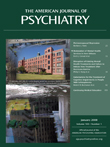Elevated Fear Conditioning to Socially Relevant Unconditioned Stimuli in Social Anxiety Disorder
Abstract
Objective: Though conditioned fear has long been acknowledged as an important etiologic mechanism in social anxiety disorder, past psychophysiological experiments have found no differences in general conditionability among social anxiety patients using generally aversive but socially nonspecific unconditioned stimuli (e.g., unpleasant odors and painful pressure). The authors applied a novel fear conditioning paradigm consisting of socially relevant unconditioned stimuli of critical facial expressions and verbal feedback. This study represents the first effort to assess the conditioning correlates of social anxiety disorder within an ecologically enhanced paradigm. Method: Subjects with social anxiety disorder and age- and gender-matched healthy comparison subjects underwent differential classical conditioning. Conditioned stimuli included images of three neutral facial expressions, each of which was paired with one of three audiovisual unconditioned stimuli: negative insults with critical faces (US neg ), positive compliments with happy faces (US pos ), or neutral comments with neutral faces (US neu ). The conditioned response was measured as the fear-potentiation of the startle-blink reflex elicited during presentation of the conditioned stimuli. Results: Only social anxiety subjects demonstrated fear conditioning in response to facial expressions, as the startle-blink reflex was potentiated by the CS neg versus both CS neu and CS pos among those with the disorder, while healthy comparison subjects displayed no evidence of conditioned startle-potentiation. Such group differences in conditioning were independent of levels of anxiety to the unconditioned stimulus, implicating associative processes rather than increased unconditioned stimulus reactivity as the active mechanism underlying enhanced conditioned startle-potentiation among social anxiety subjects. Conclusions: Results support a conditioning contribution to social anxiety disorder and underscore the importance of disorder-relevant unconditioned stimuli when studying the conditioning correlates of pathologic anxiety.



